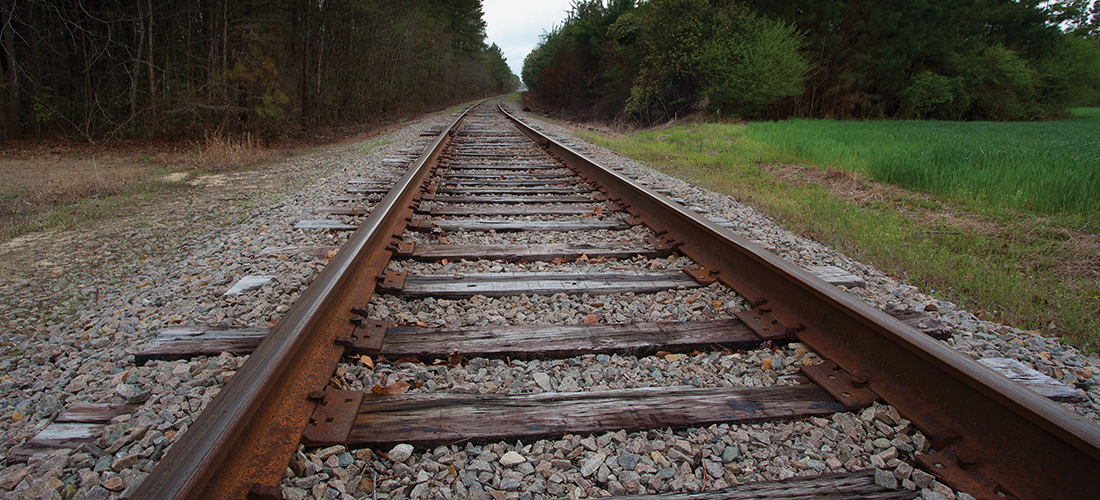
An Ear to the Ground
Sometimes you can hear the past
By Tom Bryant
It was a child’s trick remembered from early days growing up in proximity to the railroad tracks. I leaned down, put my ear to one of the rails and listened. The sound was barely discernable: a thin, humming, almost-not-there pitch. If I hadn’t done it before, I wouldn’t have known what the sound represented.
I was in Pinebluff, my old stomping grounds, aimlessly riding around the area, recalling days when I was a youngster and how much fun we had camping, exploring, growing and learning. I was standing in the middle of the railroad tracks, looking south toward Addor. I left my old Bronco parked off Pinebluff Road under an ancient pine and walked north on the tracks to locate the little sand pit that used to be nestled on the east side of the railroad.
As Boy Scouts, we camped in the area many years ago. The little cut-back in the short brush to the camping spot was easy to find, and the site looked basically the same as it did when our old Scout Troop 206 used it, maybe a little smaller. To me, as an adult, everything in Pinebluff seems smaller.
On the way back to the Bronco, I remembered how to put my ear on the track to see if I could hear an approaching train, an old trick discovered by the native Americans when they were fighting the railroads and “iron horses,” as they called the black smoke-belching locomotives. I probably learned the trick from a Roy Rogers Western in the old, long-gone Aberdeen Theatre.
It worked. There was a definite hum when I placed my ear to the rail. The sound was growing louder, but I couldn’t see anything because of a slight curve in the tracks to the south. I slowly climbed the embankment that overlooked the tracks and settled down to wait and see if the noise in the rails turned into a rumbling iron horse.
The whistle of the freight train in the distance indicated it was getting close, so I performed another tradition just as we youngsters did in the old days. I hustled down the slight incline and placed a penny on the rail. Shoot, what the heck, inflation has caught up with us, so I put a quarter beside the penny and went back to my observation point.
In just a few minutes, the huge freight train rumbled around the bend, moving slowly as it labored up the slight grade toward Aberdeen. It was massive; and as always, the sight of the big engines blowing diesel smoke had not lost its magnificence to me as I watched it move on north and out of sight.
It took a while to find the flattened quarter, and I never did find the penny, probably stuck to the wheel or lodged in the underbelly of the rail car. I took one last glance up the track toward Aberdeen and hiked back to the Bronco.
A lot has changed since, as a youngster, I walked the tracks from the ice plant in Aberdeen to our home in Pinebluff, hunting along the way. I would range out in the woods on either side of the tracks like a close hunting bird dog. I was hunting for anything in season. The game bag usually leaned heavily toward squirrels, though. When I got home, I’d clean the game, and Mom would store it in the freezer until we had enough for a real wild game feast.
My attraction to trains began early, at least according to my mother. During World War II, while Dad was moving around the country being trained for the Navy, Mom and I, an infant not yet 1 year old, followed him. We would find a small apartment and stay there until he moved on to the next training camp. Like most of the rest of the country, during those war-torn years, we always traveled by train.
After the war, Dad mustered out of the Navy in Washington D.C., boarded a slow-moving passenger train and rode it home to South Carolina. I think that was his last train ride. Although he didn’t travel by train anymore, they were an integral part of his work experience. He was the superintendent of the ice plant in Aberdeen. The plant, City Products Inc., loomed over the tracks a couple of miles south of the town. Fruit and produce freight car activity was constant 24 hours a day. A platform off to the side in the middle of switching tracks could handle 50 freight cars and enabled the plant to get ice into bunkers to refrigerate products on their way north or west.
Ice plants were strategically positioned along the north-south freight train run, enabling timely icing all the way north. I can remember plants in Florida at Miami, Lakeland, Sanford and Jacksonville, and in Florence, South Carolina, and Aberdeen, North Carolina. Aberdeen was the most productive and could manufacture and store 25,000 tons of ice. The plant was built to accommodate the Seaboard Railroad’s largest switching yard near Hamlet, North Carolina. This was where trains were made up for their ultimate destination. Seventy-five trains could be assembled for points north, south and west. It was a huge operation, and the ice plant in Aberdeen played a major part in Seaboard’s shipping plans. It was so important that the railroad had a fully staffed office in the ice plant with personnel who kept up with rail cars that needed refrigeration. The Seaboard official’s office was immediately adjacent to my dad’s.
On several occasions, I accompanied my father when he called on Seaboard offices at the switching yard in Hamlet. The yard was massive and always filled with activity with yard switching engines assembling trains for their ultimate destination. Hamlet was dubbed the “Hub of the Seaboard,” with five Seaboard Air Line railroad lines leading from the town and, at its high point, 30 passenger train departures each day.
A few days after my sojourn to the railroad tracks in Pinebluff, Linda, my bride, and I made the short ride to Hamlet to visit the restored railroad depot and see the old switching yard of the Seaboard. The CSX railroad company now owns the yard and uses it for the maintenance of freight cars.
The depot is magnificent. It received the Historic Preservation of North Carolina’s 2005 Carraway Award for outstanding restoration work by public agencies. The station is also listed on the National Register of Historic Places. It is one of the finest restored depots I’ve ever visited and was well worth our trip.
The switching yard is now more dedicated to maintenance, and not much was going on when we were there. I’ve even heard a rumor that CSX is slowly putting it in mothballs.
The Hamlet railroad depot? Amtrak does not provide ticketing or baggage service now, and only two trains come through a day.
The City Products ice plants are history. Not one left. Shortly after my return to Southern Pines, I drove down the narrow dirt road that was the only way to get to the plant by car. Nothing can be seen of the massive original structure, which was, in the past, Moore County’s largest building and you might even say Aberdeen’s skyline. All that remains is broom straw and pine trees. PS
Tom Bryant, a Southern Pines resident, is a lifelong outdoorsman and PineStraw’s Sporting Life columnist.





